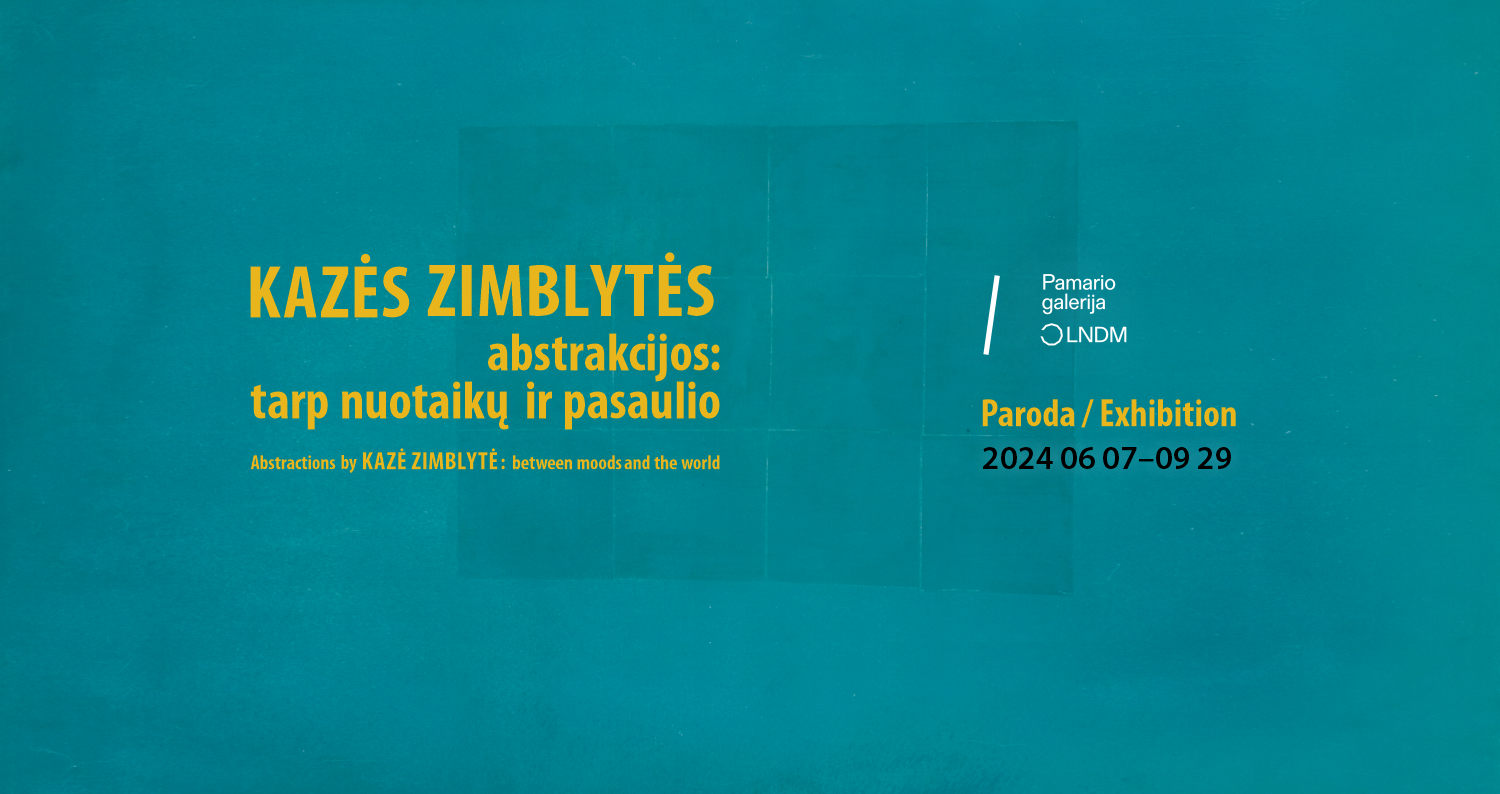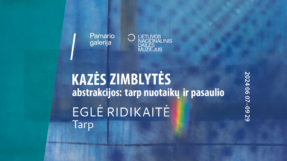Kazė Zimblytė's Abstractions: Among Moods and the World
7 June – 29 September 2024
 The exhibition „Abstractions: Among Moods and the World“ by Kazė (Kazimiera) Zimblytė, the pioneer of Lithuanian abstract painting, consists of her works from the collections of the Lithuanian National Museum of Art and opens up a distinctive language of avant-garde art to viewers. The artist transformed her creative ideas into a unique module of figurative expression: she painted in oil, watercolour, and gouache, made collages and assemblages on canvas, paper or cardboard, using different abstract compositional structures, dark or light colours, and pasted pieces of canvas, paper, leather and foil sheets onto canvas, paper or cardboard, thus conveying her own emotional states. The drama of the artist’s moods and the meanings of the colour black are revealed in her following poem:
The exhibition „Abstractions: Among Moods and the World“ by Kazė (Kazimiera) Zimblytė, the pioneer of Lithuanian abstract painting, consists of her works from the collections of the Lithuanian National Museum of Art and opens up a distinctive language of avant-garde art to viewers. The artist transformed her creative ideas into a unique module of figurative expression: she painted in oil, watercolour, and gouache, made collages and assemblages on canvas, paper or cardboard, using different abstract compositional structures, dark or light colours, and pasted pieces of canvas, paper, leather and foil sheets onto canvas, paper or cardboard, thus conveying her own emotional states. The drama of the artist’s moods and the meanings of the colour black are revealed in her following poem:
Black colour on canvas, the colour of the blackish black canvas…
The colour of the blackish black canvas…
Desperate love…
…The colour of black leather…
IDEAS. Kazimiera Zimblytė’s oeuvre is dominated by abstract philosophical ideas of the fragility of life. Her especially highly contrasting figurative solutions reveal to the viewers the world of her unique visions, where one can sense the dimension of both spiritual loneliness and true materiality. Her abstractions, without sentimentality, radiate the beauty of nature, sharply and expressively forming collage-like structures of blues, browns, greens, burgundy colours and geometric shapes. The ephemeral and poetically fragile world of her ideas is suggestively reinforced by her earlier artistic performances with strips of paper and fabric. As if fighting against the earth’s gravitation and material fragility, they depict philosophical feelings of life’s transience.
MATERIALITY AND SPATIALITY. Zimblytė’s early works of the 1950s and 1960s are characterised by experimentation with different materials. The figurative language of her paintings refers to the primordial rhythms of textiles, the patterns of weaving and braiding, and the peculiar connections between canvas, sackcloth, leather, cardboard, sheet metal and other ready-made forms of objects. In her collages and assemblages, the language of painting is appropriate. This is why painterly textile materiality and sculptural and ornamental decorativeness are often created from strips of paper, cardboard sheets or paper packaging. The spatial dimension is also important for the artist. The colours of the painted canvases are lightened or darkened at the edges, and glossy or varnished sheets of paper are glued in the corners, extending the boundaries of space. The paper on the canvas is that fragile membrane, like the wings of a butterfly, sensitive to time, dust and physical impact. Sometimes the paper is crumpled, crushed, and when straightened, it is glued and coated with a bronze sheen, as if floating in a limitless space.
COLOURS. In the paintings by the abstractionist Zimblytė, similarly to the works by the contemporary abstractionist Eugenijus Cukermanas, the colour palette is more monochromatic and restrainedly minimalist. This restraint has been compensated by complementary artistic effects: mattness, relief and gloss. Smooth, structurally decomposable, light-reflecting effects have brought the painting closer to the effects of photography, advertising hoardings and plastic products. In the 1980s, Zimblytė’s paintings had softer colour tones, and she painted several greenish, azure-greenish abstractions.
Kazimiera (Kazė) Zimblytė was born in 1933 in the village of Briedžiūnai, Ukmergė County (Central East Lithuania). From 1952 to 1959, she studied fine textiles at the Vilnius Art Institute. After graduation, she worked at the Vilnius Fine Arts Industrial Plant, designing projects for textiles and fabrics. Zimblytė was a member of the Lithuanian Artists’ Union from 1963 to 1992; starting from 1992 she was a member of the group „1“. Starting from 1959, she participated in many group exhibitions, women artists’ and applied art exhibitions. Her bright and often ornamented artworks were also exhibited in expositions in other countries: in Warsaw (Poland), Moscow (Russia), “Expo-70” in Osaka, Japan, at the international fair in Leipzig (the Democratic Republic of Germany), in France (Toulon), and elsewhere. However, her abstractions were not included in the official painting triennials and quadrennials held during the Soviet era, and she was not allowed to hold solo exhibitions in public spaces in Lithuania. Like other well-known avant-gardists Valentinas Antanavičius, Eugenijus Cukermanas, Linas Katinas, and Vincas Kisarauskas, Zimblytė exhibited her works in private, non-public or semi-public spaces: the salon of Judita and Vytautas Šerys (1968, 1971), the house of Vladas Vildžiūnas and his wife Marija Ladigaitė-Vildžiūnienė in Jėruzalė, a district of Vilnius (1978, 1979); in the apartment of the artists Rakytin in Moscow, Russia (1979), in the Vaga publishing house in Vilnius (1968), in the cinemas of Vilnius, in Vilnius Art Workers’ Palace, in the Lithuanian Writers’ Union, as well as in the land of her ancestors in the village of Briedžiūnai, and elsewhere.
The most favourable time for Kazimiera Zimblytė’s oeuvre began with the approach of the Sąjūdis national revival movement and the restoration of Lithuania’s Independence. In 1988 Zimblytė held her first official solo exhibition at the Art Exhibition Hall in Vilnius. In 1994, 1996, 1999 and 2007, she had her solo exhibitions at the „Lietuvos Aidas“ gallery, participated in international exhibitions, and received official recognition. She died in 1999 in Vilnius.
PERFORMANCES. Zimblytė carried out her exceptional avant-garde performances in the late 1960s in the courtyard and garden of the home of Vladas Vildžiūnas and his wife Marija Ladigaitė-Vildžiūnienė in Vilnius’ district of Jeruzalė. Between 1978 and 1979, documentary shots of Vildžiūnas and Zimblytė’s creative episodes were captured, which are shown in this exhibition.
Exhibition curator Nijolė Nevčesauskienė
Curator: Nijolė Nevčesauskienė
Coordinator: Aurelija Malinauskaitė
Exhibition architect: Ieva Glumac
Designer: Loreta Uzdraitė
Supported by Neringa Municipality
3 L. Rėzos st, LT-93101, Juodkrantė, Neringa, Lithuania.
+370 469 53 323, +370 46 410 412
pamario.galerija@lndm.lt














